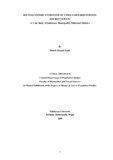Please use this identifier to cite or link to this item:
https://elibrary.tucl.edu.np/handle/123456789/3449| Title: | Socio-Economic Conditions of Child Labourer in hotel and Restaurant (A Case Study of Jaleshwor Municipality, Mahottari District) |
| Authors: | Singh, Dinesh Prasad |
| Keywords: | Child labour;Child Labourer in hotel;Socio-Economic |
| Issue Date: | 2009 |
| Publisher: | Department of Population Studies |
| Institute Name: | Central Department of Population Studies |
| Level: | Masters |
| Abstract: | Child labour is a serious and widespread problem in Nepal. Hotel and restaurant workis one of the most visible and hazardous forms of child labor where it is common inthe urban areas of Nepal. It affects their health, their education and their prospects forthe future. They are among the most neglected, abused and exploited segments of thepopulation. The present study concerns with the child laborers employed in hotels andrestaurants in Jaleshowor Municipality, Mahottary district. The study gatheredinformation on hotel, and restaurant child labourer's socio-economic condition, theirworking condition, root causes of being labourers and problems faced by them. Bothprimary and secondary data have been used and various research techniques wereapplied to collect the required data for the study. The child labourers come from almost all parts of the country and few fromneighbouring country, India they are from almost all castes and ethnic groups.Majority of children fall within the 12-14 years age group. Out of the total 76 percent children are females and 24 percent are males. Amongthem 71 percent belong to the age group 10-14 years, whereas about 44 percent arefemales and about 56 percent are males. Majority of the child labourers are foundlocal. Out of the total respondents, 56 percent belong to the families between 6-9members. Similarly, about 54 percent children’s families are found to engage inagriculture and 61 percent child labourers are illiterate. 45 percent child laborers haveleft their home by the causes of lack offood, 20 percent parent’s suggestions. Majority of the child labourers are involved in unskilled works. The main work of thechild labourers is washing dishes and clothes. About 36 percent child laboures getRs.251-400 per month. Cough, cold and fever are the common health problems forchild labourers. More than 73 percent child labourers are punished by their employees82 percent children get clothes from their masters and 33 percent child labourers wantto study in future. |
| URI: | http://elibrary.tucl.edu.np/handle/123456789/3449 |
| Appears in Collections: | Population Studies |
Files in This Item:
| File | Description | Size | Format | |
|---|---|---|---|---|
| THESIS.pdf | 339.08 kB | Adobe PDF |  View/Open |
Items in DSpace are protected by copyright, with all rights reserved, unless otherwise indicated.
